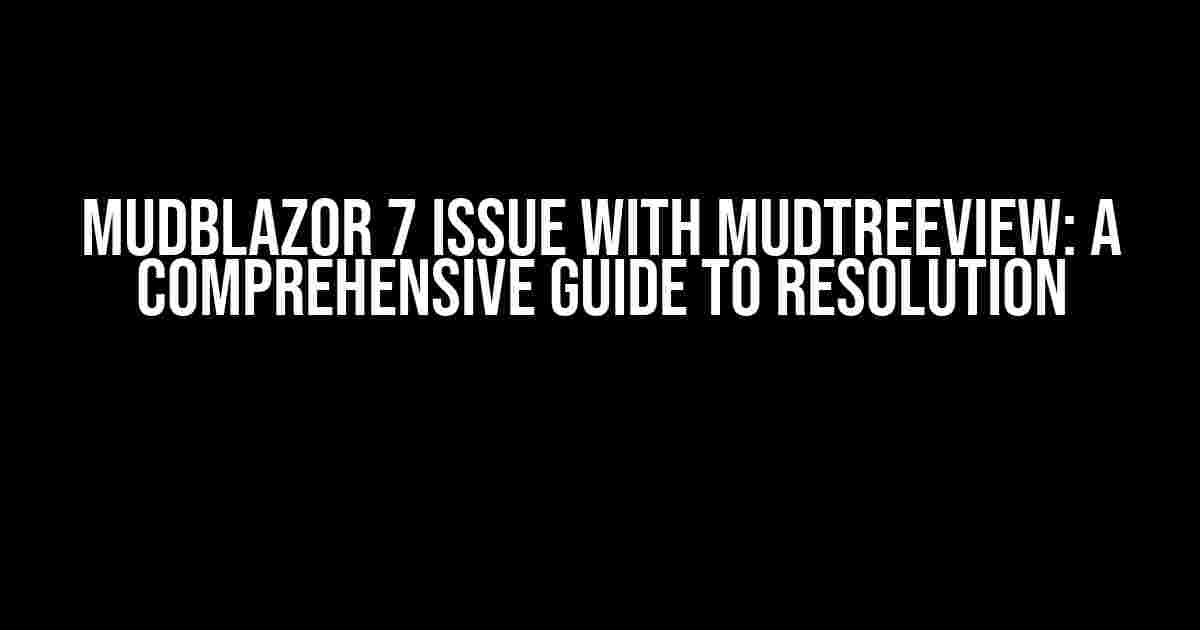If you’re a web developer working with MudBlazor 7, you may have encountered an annoying issue with the MudTreeView component. This component is an essential part of the MudBlazor framework, allowing you to create hierarchical tree structures in your applications. However, some developers have reported issues with the MudTreeView, particularly in MudBlazor 7. In this article, we’ll delve into the common issues and provide step-by-step solutions to get your MudTreeView up and running smoothly.
Understanding the MudTreeView Component
The MudTreeView is a versatile component in the MudBlazor framework, designed to display hierarchical data in a tree-like structure. It’s commonly used to represent file systems, organizational charts, or any other data that requires a nested structure. The MudTreeView consists of nodes, which can be expanded or collapsed to reveal or hide child nodes.
Troubleshooting Common Issues
Before we dive into the solutions, let’s identify some common issues you might encounter with the MudTreeView in MudBlazor 7:
- Nodes not expanding or collapsing correctly
- Child nodes not displaying properly
- Tree structure not rendering correctly
- Errors when using templates or binding data
Solution 1: Update MudBlazor to the Latest Version
Sometimes, issues can arise due to outdated packages. Ensure you’re running the latest version of MudBlazor 7. You can update MudBlazor using the following command in your terminal:
dotnet add package MudBlazor --version 7.0.3Replace “7.0.3” with the latest version available.
Solution 2: Verify Node Structure and Data Binding
A common mistake is incorrect node structure or data binding. Double-check your code to ensure you’re using the correct syntax and data binding methods.
Here’s an example of a correctly structured MudTreeView:
<MudTreeView>
<MudTreeViewNode>
<MudTreeViewNodeContent>Parent Node</MudTreeViewNodeContent>
<MudTreeViewNode>
<MudTreeViewNodeContent>Child Node 1</MudTreeViewNodeContent>
</MudTreeViewNode>
<MudTreeViewNode>
<MudTreeViewNodeContent>Child Node 2</MudTreeViewNodeContent>
</MudTreeViewNode>
</MudTreeViewNode>
</MudTreeView>When binding data, use the ` Items` property to pass your data to the MudTreeView:
<MudTreeView Items="@treeData">
<MudTreeViewNode>
<MudTreeViewNodeContent>@context.Label</MudTreeViewNodeContent>
</MudTreeViewNode>
</MudTreeView>
@code {
private List<TreeNode> treeData = new List<TreeNode>()
{
new TreeNode() { Label = "Parent Node" },
new TreeNode() { Label = "Child Node 1" },
new TreeNode() { Label = "Child Node 2" }
};
}Solution 3: Check for Template Issues
If you’re using templates with your MudTreeView, ensure you’re not encountering any template-related issues. Verify that your templates are correctly defined and used.
Here’s an example of a correctly used template:
<MudTreeView>
<MudTreeViewNode>
<MudTreeViewNodeContent>
<template><span>@context.Label</span></template>
</MudTreeViewNodeContent>
</MudTreeViewNode>
</MudTreeView>Solution 4: Inspect JavaScript Errors
Sometimes, JavaScript errors can cause issues with the MudTreeView. Open your browser’s developer tools and inspect the console for any errors. Resolve any errors you find, and your MudTreeView should function correctly.
Solution 5: Verify CSS and Styling
CSS and styling issues can also affect the MudTreeView’s appearance and functionality. Ensure you’re using the correct CSS classes and styles for your MudTreeView.
Here’s an example of adding custom CSS styles to your MudTreeView:
<style>
.mud-treeview {
font-size: 16px;
font-weight: bold;
}
</style>
<MudTreeView Class="mud-treeview">...</MudTreeView>Conclusion
In this article, we’ve covered the most common issues you might encounter with the MudTreeView in MudBlazor 7, along with step-by-step solutions to resolve them. By following these guidelines, you should be able to get your MudTreeView up and running smoothly.
Additional Tips and Tricks
Here are some additional tips to keep in mind when working with the MudTreeView:
- Use the `ExpandAll` and `CollapseAll` methods to programmatically control node expansion and collapse.
- Implement custom node templates to customize the appearance and behavior of your tree nodes.
- Use the `SelectedItem` property to track the currently selected node.
Final Thoughts
The MudTreeView is a powerful component in the MudBlazor framework, and with these solutions and tips, you should be able to overcome any issues you encounter. Remember to stay up-to-date with the latest version of MudBlazor, and don’t hesitate to reach out to the community for help if you need it.
| Solution | Description |
|---|---|
| Update MudBlazor | Ensure you’re running the latest version of MudBlazor 7. |
| Verify Node Structure and Data Binding | Double-check your node structure and data binding to ensure correct syntax and data binding methods. |
| Check for Template Issues | Verify that your templates are correctly defined and used. |
| Inspect JavaScript Errors | Open your browser’s developer tools and inspect the console for any errors. |
| Verify CSS and Styling | Ensure you’re using the correct CSS classes and styles for your MudTreeView. |
By following these solutions and tips, you’ll be well on your way to mastering the MudTreeView component in MudBlazor 7.
Frequently Asked Question
Having trouble with MudBlazor 7 and MudTreeView? Don’t worry, we’ve got you covered! Check out these frequently asked questions and answers to get you back on track.
Why does my MudTreeView not display any child nodes?
Make sure you’re using the correct `Items` property and that it’s bound to a valid collection of items. Also, double-check that your `ChildContent` is correctly defined and that you’re not missing any necessary templates.
How do I customize the appearance of my MudTreeView?
You can customize the appearance of your MudTreeView by using CSS or by overriding the default templates. For example, you can use the `Class` property to add custom CSS classes to your tree view nodes.
Why does my MudTreeView not update when the underlying data changes?
Make sure you’re using a two-way binding on your `Items` property and that you’re raising the necessary property changed notifications when your underlying data changes.
Can I use MudTreeView with a hierarchical data structure?
Yes, MudTreeView is designed to work with hierarchical data structures. You can use the `Items` property to bind to a collection of items, and the `ChildContent` property to define the template for child nodes.
How do I handle node selection and expansion events in MudTreeView?
You can handle node selection and expansion events by using the `NodeSelected` and `NodeExpanded` events on the MudTreeView component. These events provide access to the selected or expanded node, allowing you to perform custom logic or update your application state.

